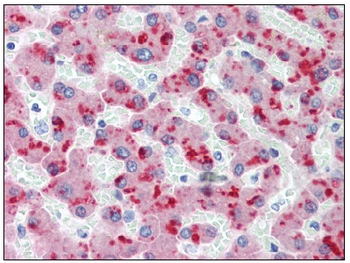Factor H (CFH) Mouse Monoclonal Antibody [Clone ID: OX-24]
Other products for "CFH"
Specifications
| Product Data | |
| Clone Name | OX-24 |
| Applications | ELISA, IHC, IP, WB |
| Recommended Dilution | ELISA. Immunohistochemistry on Paraffin Sections: 10 µg/ml. Immunoprecipitation. Western Blot. |
| Reactivities | Human |
| Host | Mouse |
| Isotype | IgG1 |
| Clonality | Monoclonal |
| Immunogen | Purified Human complement factor H protein. |
| Specificity | Recognizes the Human serum complement protein factor H (155kD), binding to a different epitope from OX23. Recognizes a 43-49kD truncated form of factor H present at low level (1-5 µg/ml) in plasma and urine. In an Immunoprecipitation system, recognizes Factor H in other primates, but not in Bovine, Sheep, Pig, Chicken or Rabbit sera. This antibody inhibits the binding of factor H to surface bound C3b. Recognizes Factor H in Western blotting procedures. |
| Formulation | State: Purified State: Liquid purified Ig fraction containing 0.09% Sodium Azide as preservative. |
| Concentration | lot specific |
| Purification | Protein G Chromatography. |
| Storage | Store the antibody undiluted at 2-8°C for one month or (in aliquots) at -20°C for longer. Avoid repeated freezing and thawing. |
| Stability | Shelf life: one year from despatch. |
| Gene Name | Homo sapiens complement factor H (CFH), transcript variant 1 |
| Database Link | |
| Background | The complement Factor H protein is secreted into the bloodstream and acts in the regulation of complement activation. Mutations leading to changes in this protein have been linked with HUS (hemolytic-uremic syndrome) and chronic hypocomplementemic nephropathy. Factor H is mainly synthesised in the liver but also in macrophages and endothelium. It is primarily aplasma glycoprotein but is also found in platelets and there is a membrane bound form on some leukocytes. Consisting of a single polypeptide, the major form of Factor H has a molecular weight of 155kDa. There are two truncated forms, a non-glycosylated 49 kDa form and a glycosylated 39-43 kDaform. Plasma concentrations are in the range 200-600mg/L for the 155 kDa form and 1-5mg/L for thetruncated forms. Factor H is a major regulatory protein of the complement system. By binding to C3b it either displacesor prevents the binding of Bb (activated Factor B). When bound to Factor H, C3b is susceptible tocleavage by Factor 1 to yield iC3b. Factor H is released or modified following this cleavage. The regulatory role of Factor H is essential because C3bBb is not only a C5 convertase but a C3 convertaseand so has a positive feedback effect, potentially consuming the entire C3 pool if unregulated. |
| Synonyms | CFH, HF, HF1, HF2, H factor 1 |
| Reference Data | |
| Protein Families | Druggable Genome, Secreted Protein |
| Protein Pathways | Complement and coagulation cascades |
Documents
| Product Manuals |
| FAQs |
{0} Product Review(s)
0 Product Review(s)
Submit review
Be the first one to submit a review
Product Citations
*Delivery time may vary from web posted schedule. Occasional delays may occur due to unforeseen
complexities in the preparation of your product. International customers may expect an additional 1-2 weeks
in shipping.






























































































































































































































































 Germany
Germany
 Japan
Japan
 United Kingdom
United Kingdom
 China
China




